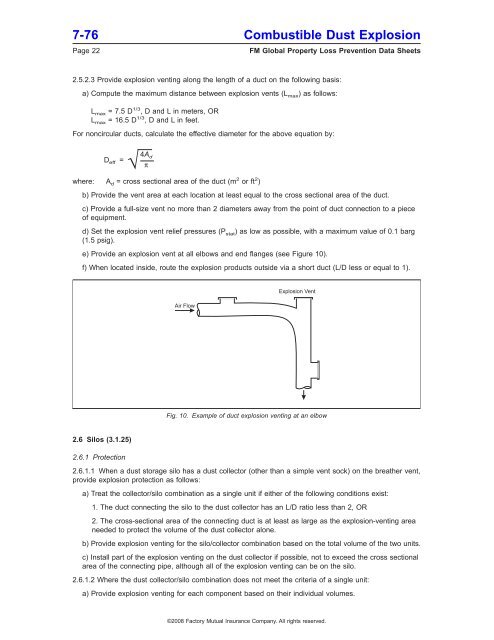DS 7-76 Prevention and Mitigation of Combustible Dust ... - FM Global
DS 7-76 Prevention and Mitigation of Combustible Dust ... - FM Global
DS 7-76 Prevention and Mitigation of Combustible Dust ... - FM Global
Create successful ePaper yourself
Turn your PDF publications into a flip-book with our unique Google optimized e-Paper software.
7-<strong>76</strong> <strong>Combustible</strong> <strong>Dust</strong> Explosion<br />
Page 22 <strong>FM</strong> <strong>Global</strong> Property Loss <strong>Prevention</strong> Data Sheets<br />
2.5.2.3 Provide explosion venting along the length <strong>of</strong> a duct on the following basis:<br />
a) Compute the maximum distance between explosion vents (L max) as follows:<br />
L max = 7.5 D 1/3 , D <strong>and</strong> L in meters, OR<br />
L max = 16.5 D 1/3 , D <strong>and</strong> L in feet.<br />
For noncircular ducts, calculate the effective diameter for the above equation by:<br />
D eff = √ 4A d<br />
π<br />
where: A d = cross sectional area <strong>of</strong> the duct (m 2 or ft 2 )<br />
b) Provide the vent area at each location at least equal to the cross sectional area <strong>of</strong> the duct.<br />
c) Provide a full-size vent no more than 2 diameters away from the point <strong>of</strong> duct connection to a piece<br />
<strong>of</strong> equipment.<br />
d) Set the explosion vent relief pressures (P stat) as low as possible, with a maximum value <strong>of</strong> 0.1 barg<br />
(1.5 psig).<br />
e) Provide an explosion vent at all elbows <strong>and</strong> end flanges (see Figure 10).<br />
f) When located inside, route the explosion products outside via a short duct (L/D less or equal to 1).<br />
2.6 Silos (3.1.25)<br />
2.6.1 Protection<br />
Fig. 10. Example <strong>of</strong> duct explosion venting at an elbow<br />
2.6.1.1 When a dust storage silo has a dust collector (other than a simple vent sock) on the breather vent,<br />
provide explosion protection as follows:<br />
a) Treat the collector/silo combination as a single unit if either <strong>of</strong> the following conditions exist:<br />
1. The duct connecting the silo to the dust collector has an L/D ratio less than 2, OR<br />
2. The cross-sectional area <strong>of</strong> the connecting duct is at least as large as the explosion-venting area<br />
needed to protect the volume <strong>of</strong> the dust collector alone.<br />
b) Provide explosion venting for the silo/collector combination based on the total volume <strong>of</strong> the two units.<br />
c) Install part <strong>of</strong> the explosion venting on the dust collector if possible, not to exceed the cross sectional<br />
area <strong>of</strong> the connecting pipe, although all <strong>of</strong> the explosion venting can be on the silo.<br />
2.6.1.2 Where the dust collector/silo combination does not meet the criteria <strong>of</strong> a single unit:<br />
a) Provide explosion venting for each component based on their individual volumes.<br />
©2008 Factory Mutual Insurance Company. All rights reserved.

















